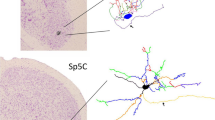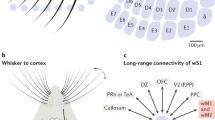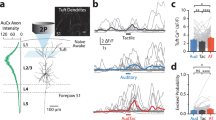Abstract
The cortical forepaw area of young adult rats was mapped by recording the response properties of small clusters of neurons in layer IV of the primary somatosensory (SI) cortex. First we quantitatively analyzed the somatotopic organizational features of the cortical forepaw representation in terms of areal extent and topography, receptive field (RF) sensory modality, size, and location. We also assessed the influence of environmental enrichment, known to induce structural alterations in cortical connectivity, on the representational characteristics of the forepaw maps. Long-Evans rats were housed in environments (standard, SE; enriched, EE) promoting differential tactile experience for 71–113 days from weaning. Within the SI, we found a single and complete topographic map of the cutaneous surfaces of the forepaw consisting of a rostrolateral-caudomedial sequence of digit and pad representational zones. Small islets of noncutaneous responses (NCR; high-threshold, deep-receptor input) within the boundaries of the cutaneous maps were a conspicuous feature of the forepaw map for SE rats. These islets created discontinuities in the representation of contiguous skin territories. In the SE rats, about 79% of the cortical sites activated by light tactile stimulation had a single cutaneous RF, whereas about 21% exhibited multiple RFs. Most single-digit RFs we delineated in the SE rats extended across two or three phalanges. As a result, the representations of the phalangeal skin surfaces were not segregated but formed an overlapping continuum. Moreover, within these regions, as the electrode was displaced in regular steps across the mediolateral axis, RFs did not shift across the digit skin surface in an orderly manner, suggesting a lack of internal topography in the finger representation zones. Tactile experience promoted by environmental enrichment induced alterations in the representational features of the SI cutaneous map of the forepaw. In EE rats, the areal extent of the forepaw cutaneous representation was 1.5 times larger than in SE rats. Indeed, the cutaneous map extended into NCR cortical sectors along its external margins and also into NCR islets found in the forepaw area. Consequently, in EE rats there were fewer representational discontinuities. The areal enlargement was due to a selective increase in the areal extent of the glabrous but not the hairy skin surface representations. Furthermore, protuberant glabrous skin (digit tips, palmar pads) was represented over larger cortical regions than were other glabrous skin territories less likely to be stimulated during object palpation and manipulation. Maps from EE rats were also characterized by a larger proportion of sites with single RFs (88% compared with 79%). In addition, glabrous RFs from EE rats were smaller and more clustered on the digit tips and palmar pads than were RFs in SE rat maps. RF size on hairy skin surfaces remained unchanged. Because the RFs were smaller, the cutaneous maps of EE rats contained distinct representations of digit phalangeal glabrous skin. RFs tended to exhibit more orderliness in their progression across the digit glabrous skin of EE rats than they did in SE rats. The phalanges of EE rats were represented in distinct patches. Neurons in EE rats were more sensitive to light tactile stimulation than were neurons in SE rats. These alterations were presumably mediated by the selective potentiation of cutaneous over deep-receptor activation. More generally, the present study corroborates the view that cortical cutaneous maps are maintained in a permanent state of use-dependent fluctuation.
Similar content being viewed by others
Author information
Authors and Affiliations
Additional information
Received: 3 June 1997 / Accepted: 11 November 1997
Rights and permissions
About this article
Cite this article
Coq, JO., Xerri, C. Environmental enrichment alters organizational features of the forepaw representation in the primary somatosensory cortex of adult rats. Exp Brain Res 121, 191–204 (1998). https://doi.org/10.1007/s002210050452
Issue Date:
DOI: https://doi.org/10.1007/s002210050452




